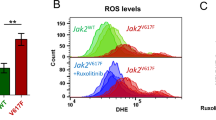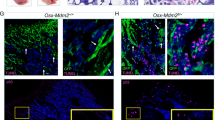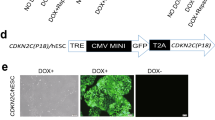Abstract
Hypoxia-inducible factor (HIF)-1α accumulation promotes hematopoietic stem cells’ quiescence and is necessary to maintain their self-renewal. However, the role of HIF-2α in hematopoietic cells is less clear. We investigated the role of HIF-2α in leukemia and lymphoma cells. HIF-2α expression was high in subsets of human and mouse leukemia and lymphoma cells, whereas it was low in normal bone marrow leukocytes. To investigate the role of HIF-2α, we transduced human HIF-2α cDNA in mouse syngeneic models of myeloid preleukemia and a transgenic model of B lymphoma. Ectopic expression of HIF-2α accelerated leukemia cell proliferation in vitro. Mice transplanted with cells transduced with HIF-2α died significantly faster of leukemia or B lymphoma than control mice transplanted with empty vector-transduced cells. Conversely, HIF-2α knockdown in human myeloid leukemia HL60 cells decreased proliferation in vitro and significantly prolonged animal survival following transplantation. In human acute myeloid leukemia (AML), HIF-2α mRNA was significantly elevated in several subsets such as the t(15;17), inv(16), complex karyotype and favorable cytogenetic groups. However, patients with high HIF-2α expression had a trend to higher disease-free survival in univariate analysis. The different effects of HIF-2α overexpression in mouse models of leukemia and human AML illustrates the complexity of this mutliclonal disease.
This is a preview of subscription content, access via your institution
Access options
Subscribe to this journal
Receive 12 print issues and online access
$259.00 per year
only $21.58 per issue
Buy this article
- Purchase on Springer Link
- Instant access to full article PDF
Prices may be subject to local taxes which are calculated during checkout





Similar content being viewed by others
References
Burnett A, Wetzler M, Löwenberg B . Therapeutic advances in acute myeloid leukemia. J Clin Oncol 2011; 29: 487–494.
Ishikawa F, Yoshida S, Saito Y, Hijikata A, Kitamura H, Tanaka S et al. Chemotherapy-resistant human AML stem cells home to and engraft within the bone-marrow endosteal region. Nat Biotech 2007; 25: 1315–1321.
Saito Y, Kitamura H, Hijikata A, Tomizawa-Murasawa M, Tanaka S, Takagi S et al. Identification of therapeutic targets for quiescent, chemotherapy-resistant human leukemia stem cells. Sci Transl Med 2010; 2: 17ra19.
Saito Y, Uchida N, Tanaka S, Suzuki N, Tomizawa-Murasawa M, Sone A et al. Induction of cell cycle entry eliminates human leukemia stem cells in a mouse model of AML. Nat Biotech 2010; 28: 275–280.
Bissell MJ, Hines WC . Why don’t we get more cancer? A proposed role of the microenvironment in restraining cancer progression. Nat Med 2011; 17: 320–329.
Gao D, Joshi N, Choi H, Ryu S, Hahn M, Catena R et al. Myeloid progenitor cells in the premetastatic lung promote metastases by inducing mesenchymal to epithelial transition. Cancer Res 2012; 72: 1384–1394.
Gao D, Mittal V . The role of bone-marrow-derived cells in tumor growth, metastasis initiation and progression. Trends Mol Med 2009; 15: 333–343.
Jinushi M, Chiba S, Yoshiyama H, Masutomi K, Kinoshita I, Dosaka-Akita H et al. Tumor-associated macrophages regulate tumorigenicity and anticancer drug responses of cancer stem/initiating cells. Proc Natl Acad Sci USA 2011; 108: 12425–12430.
Walkley CR, Olsen GH, Dworkin S, Fabb SA, Swann J, McArthur GA et al. A microenvironment-Induced myeloproliferative syndrome caused by retinoic acid receptor gamma deficiency. Cell 2007; 129: 1097–1110.
Raaijmakers MHGP, Mukherjee S, Guo S, Zhang S, Kobayashi T, Schoonmaker JA et al. Bone progenitor dysfunction induces myelodysplasia and secondary leukaemia. Nature 2010; 464: 852–857.
Raaijmakers MHGP . Niche contributions to oncogenesis: emerging concepts and implications for the hematopoietic system. Haematologica 2011; 96: 1041–1048.
Lane SW, Scadden DT, Gilliland DG . The leukemic stem cell niche: current concepts and therapeutic opportunities. Blood 2009; 114: 1150–1157.
Vaupel P . Tumor microenvironmental physiology and its implications for radiation oncology. Semin Radiat Oncol 2004; 14: 198–206.
Moulder J, Rockwell S . Tumor hypoxia: its impact on cancer therapy. Cancer Metast Rev 1987; 5: 313–341.
van Laarhoven HW, Bussink J, Lok J, Punt CJ, Heerschap A, van Der Kogel AJ . Effects of nicotinamide and carbogen in different murine colon carcinomas: immunohistochemical analysis of vascular architecture and microenvironmental parameters. Int J Radiat Oncol Biol Phys 2004; 60: 310–321.
Das B, Tsuchida R, Malkin D, Koren G, Baruchel S, Yeger H . Hypoxia enhances tumor stemness by increasing the invasive and tumorigenic side population fraction. Stem Cells 2008; 26: 1818–1830.
Pistollato F, Abbadi S, Rampazzo E, Persano L, Della Puppa A, Frasson C et al. Intratumoral hypoxic gradient drives stem cells distribution and MGMT expression in glioblastoma. Stem Cells 2010; 28: 851–862.
Ceradini DJ, Kulkarni AR, Callaghan MJ, Tepper OM, Bastidas N, Kleinman ME et al. Progenitor cell trafficking is regulated by hypoxic gradients through HIF-1 induction of SDF-1. Nat Med 2004; 10: 858–864.
Kaelin WG Jr. . Cancer and altered metabolism: potential importance of hypoxia-inducible factor and 2-oxoglutarate-dependent dioxygenases. Cold Spring Harb Symp Quant Biol 2011; 76: 335–345.
Maynard MA, Ohh M . The role of hypoxia-inducible factors in cancer. Cell Mol Life Sci 2007; 64: 2170–2180.
Semenza GL . HIF-1 mediates metabolic responses to intratumoral hypoxia and oncogenic mutations. J Clin Invest 2013; 123: 3664–3671.
Warburg O . On the origin of cancer cells. Science 1956; 123: 309–314.
Covello KL, Simon MC HIFs, hypoxia, and vascular development. In: Gerald PS (ed). Current Topics in Developmental Biology. Academic Press, 2004; 62: 37–54.
Webb J, Coleman M, Pugh C . Hypoxia, hypoxia-inducible factors (HIF), HIF hydroxylases and oxygen sensing. Cell Mol Life Sci 2009; 66: 3539–3554.
Jiang BH, Semenza GL, Bauer C, Marti HH . Hypoxia-inducible factor 1 levels vary exponentially over a physiologically relevant range of O2 tension. Am J Physiol 1996; 271: C1172–C1180.
Ivan M, Kondo K, Yang H, Kim W, Valiando J, Ohh M et al. HIFalpha targeted for VHL-mediated destruction by proline hydroxylation: implications for O2 sensing. Science 2001; 292: 464–468.
Jaakkola P, Mole DR, Tian YM, Wilson MI, Gielbert J, Gaskell SJ et al. Targeting of HIF-alpha to the von Hippel-Lindau ubiquitylation complex by O2-regulated prolyl hydroxylation. Science 2001; 292: 468–472.
Lassailly F, Foster K, Lopez-Onieva L, Currie E, Bonnet D . Multimodal imaging reveals structural and functional heterogeneity in different bone marrow compartments: functional implications on hematopoietic stem cells. Blood 2013; 122: 1730–1740.
Winkler IG, Barbier V, Wadley R, Zannettino ACW, Williams S, Levesque J-P . Positioning of bone marrow hematopoietic and stromal cells relative to blood flow in vivo: serially reconstituting hematopoietic stem cells reside in distinct nonperfused niches. Blood 2010; 116: 375–385.
Spencer JA, Ferraro F, Roussakis E, Klein A, Wu J, Runnels JM et al. Direct measurement of local oxygen concentration in the bone marrow of live animals. Nature 2014; 508: 269–273.
Takubo K, Goda N, Yamada W, Iriuchishima H, Ikeda E, Kubota Y et al. Regulation of the HIF-1alpha level is essential for hematopoietic stem cells. Cell Stem Cell 2010; 7: 391–402.
Nombela-Arrieta C, Pivarnik G, Winkel B, Canty KJ, Harley B, Mahoney JE et al. Quantitative imaging of haematopoietic stem and progenitor cell localization and hypoxic status in the bone marrow microenvironment. Nat Cell Biol 2013; 15: 533–543.
Danet GH, Pan Y, Luongo JL, Bonnet DA, Simon MC . Expansion of human SCID-repopulating cells under hypoxic conditions. J Clin Invest 2003; 112: 126–135.
Eliasson P, Rehn M, Hammar P, Larsson P, Sirenko O, Flippin LA et al. Hypoxia mediates low cell-cycle activity and increases the proportion of long-term-reconstituting hematopoietic stem cells during in vitro culture. Exp Hematol 2010; 38: e302.
Forristal CE, Winkler IG, Nowlan B, Barbier V, Walkinshaw G, Levesque JP . Pharmacologic stabilization of HIF-1alpha increases hematopoietic stem cell quiescence in vivo and accelerates blood recovery after severe irradiation. Blood 2013; 121: 759–769.
Guitart AV, Subramani C, Armesilla-Diaz A, Smith G, Sepulveda C, Gezer D et al. Hif-2α is not essential for cell-autonomous hematopoietic stem cell maintenance. Blood 2013; 122: 1741–1745.
Fatrai S, Wierenga ATJ, Daenen SMGJ, Vellenga E, Schuringa JJ . Identification of HIF2α as an important STAT5 target gene in human hematopoietic stem cells. Blood 2011; 117: 3320–3330.
Levesque J-P, Winkler IG, Hendy J, Williams B, Helwani F, Barbier V et al. Hematopoietic progenitor cell mobilization results in hypoxia with increased hypoxia-inducible transcription factor-1α and vascular endothelial growth factor A in bone marrow. Stem Cells 2007; 25: 1954–1965.
Forristal CE, Nowlan B, Jacobsen RN, Barbier V, Walkinshaw G, Walkley CR et al. HIF-1α is required for hematopoietic stem cell mobilization and 4-prolyl hydroxylase inhibitors enhance mobilization by stabilizing HIF-1α. Leukemia 2015; e-pub ahead of print 12 January 2015 doi:10.1038/leu.2015.8.
Forristal CE, Christensen DR, Chinnery FE, Petruzzelli R, Parry KL, Sanchez-Elsner T et al. Environmental oxygen tension regulates the energy metabolism and self-renewal of human embryonic stem cells. PLoS One 2013; 8: e62507.
Rouault-Pierre K, Lopez-Onieva L, Foster K, Anjos-Afonso F, Lamrissi-Garcia I, Serrano-Sanchez M et al. HIF-2α protects human hematopoietic stem/progenitors and acute myeloid leukemic cells from apoptosis induced by endoplasmic reticulum stress. Cell Stem Cell 2013; 13: 549–563.
Fiegl M, Samudio I, Clise-Dwyer K, Burks JK, Mnjoyan Z, Andreeff M . CXCR4 expression and biologic activity in acute myeloid leukemia are dependent on oxygen partial pressure. Blood 2009; 113: 1504–1512.
Benito J, Shi Y, Szymanska B, Carol H, Boehm I, Lu H et al. pronounced hypoxia in models of murine and human leukemia: high efficacy of hypoxia-activated prodrug PR-104. PLoS One 2011; 6: e23108.
Gordan JD, Bertout JA, Hu CJ, Diehl JA, Simon MC . HIF-2alpha promotes hypoxic cell proliferation by enhancing c-myc transcriptional activity. Cancer Cell 2007; 11: 335–347.
Koshiji M, Kageyama Y, Pete EA, Horikawa I, Barrett JC, Huang LE . HIF-1[alpha] induces cell cycle arrest by functionally counteracting Myc. EMBO J 2004; 23: 1949–1956.
Forristal CE, Wright KL, Hanley NA, Oreffo RO, Houghton FD . Hypoxia inducible factors regulate pluripotency and proliferation in human embryonic stem cells cultured at reduced oxygen tensions. Reproduction 2010; 139: 85–97.
Liem NLM, Papa RA, Milross CG, Schmid MA, Tajbakhsh M, Choi S et al. Characterization of childhood acute lymphoblastic leukemia xenograft models for the preclinical evaluation of new therapies. Blood 2004; 103: 3905–3914.
Duhrsen U, Metcalf D . Effects of irradiation of recipient mice on the behavior and leukemogenic potential of factor-dependent hematopoietic cell lines. Blood 1990; 75: 190–197.
Egle A, Harris AW, Bath ML, O'Reilly L, Cory S . VavP-Bcl2 transgenic mice develop follicular lymphoma preceded by germinal center hyperplasia. Blood 2004; 103: 2276–2283.
Ogilvy S, Metcalf D, Print CG, Bath ML, Harris AW, Adams JM . Constitutive Bcl-2 expression throughout the hematopoietic compartment affects multiple lineages and enhances progenitor cell survival. Proc Natl Acad Sci USA 1999; 96: 14943–14948.
Winkler IG, Bendall LJ, Forristal CE, Helwani F, Nowlan B, Barbier V et al. B-lymphopoiesis is stopped by mobilizing doses of G-CSF and is rescued by overexpression of the anti-apoptotic protein Bcl2. Haematologica 2013; 98: 325–333.
Martin SK, Diamond P, Williams SA, To LB, Peet DJ, Fujii N et al. Hypoxia-inducible factor-2 is a novel regulator of aberrant CXCL12 expression in multiple myeloma plasma cells. Haematologica 2010; 95: 776–784.
Biswas S, Troy H, Leek R, Chung YL, Li JL, Raval RR et al. Effects of HIF-1alpha and HIF2alpha on growth and metabolism of clear-cell renal cell carcinoma 786-0 xenografts. J Oncol 2010; 2010: 757908.
Choi H, Chun Y-S, Kim T-Y, Park J-W . HIF-2α enhances β-catenin/TCF-driven transcription by interacting with β-catenin. Cancer Res 2010; 70: 10101–10111.
Patel SA, Simon MC . Biology of hypoxia-inducible factor-2[alpha] in development and disease. Cell Death Differ 2008; 15: 628–634.
Covello KL, Kehler J, Yu H, Gordan JD, Arsham AM, Hu CJ et al. HIF-2alpha regulates Oct-4: effects of hypoxia on stem cell function, embryonic development, and tumor growth. Genes Dev 2006; 20: 557–570.
Franovic A, Holterman CE, Payette J, Lee S . Human cancers converge at the HIF-2α oncogenic axis. Proc Natl Acad Sci USA 2009; 106: 21306–21311.
Coltella N, Percio S, Valsecchi R, Cuttano R, Guarnerio J, Ponzoni M et al. HIF factors cooperate with PML-RARalpha to promote acute promyelocytic leukemia progression and relapse. EMBO Mol Med 2014; 6: 640–650.
Ding L, Ley TJ, Larson DE, Miller CA, Koboldt DC, Welch JS et al. Clonal evolution in relapsed acute myeloid leukaemia revealed by whole-genome sequencing. Nature 2012; 481: 506–510.
Hughes AE, Magrini V, Demeter R, Miller CA, Fulton R, Fulton LL et al. Clonal architecture of secondary acute myeloid leukemia defined by single-cell sequencing. PLoS Genet 2014; 10: e1004462.
Welch JS, Ley TJ, Link DC, Miller CA, Larson DE, Koboldt DC et al. The origin and evolution of mutations in acute myeloid leukemia. Cell 2012; 150: 264–278.
Klco JM, Spencer DH, Miller CA, Griffith M, Lamprecht TL, O'Laughlin M et al. Functional heterogeneity of genetically defined subclones in acute myeloid leukemia. Cancer Cell 2014; 25: 379–392.
Grimwade D, Hills RK, Moorman AV, Walker H, Chatters S, Goldstone AH et al. Refinement of cytogenetic classification in acute myeloid leukemia: determination of prognostic significance of rare recurring chromosomal abnormalities among 5876 younger adult patients treated in the United Kingdom Medical Research Council trials. Blood 2010; 116: 354–365.
Acknowledgements
This work was supported by Project Grant no. 604303 from the National Health and Medical Research Council of Australia (to JPL and IGW) and additional support from the Mater Foundation. JPL and IGW are supported by a Senior Research Fellowship no. 1044091 and a Career Development Fellowship (no. 1033736) and FMH was supported by an Australian Based Biomedical Fellowship (no. 488821) from the National Health and Medical Research Council. We are indebted to Dr DJ Peet (University of Adelaide, Australia) who provided plasmid containing full-length human HIF-2α cDNA to Dr RB Lock (Children's Cancer Institute, Sydney, Australia) for providing B-ALL patient derived xenografts, and to Dr AW Boyd (Queensland Institute of Medical Research, Herston, Australia) for providing LK63 and REH cell lines.
Author Contributions
CEF, FMH, AB, JP, BN, VB, SM and DP performed the experiments. CEF, FMH, IGW, AB, JP, ACWZ, RDA, IL and JPL designed and planned the experiments, analyzed and discussed the results. RDA edited the manuscript. CEF, AB and JPL wrote the manuscript.
Author information
Authors and Affiliations
Corresponding author
Ethics declarations
Competing interests
The authors declare no conflict of interest.
Additional information
Supplementary Information accompanies this paper on the Leukemia website
Rights and permissions
About this article
Cite this article
Forristal, C., Brown, A., Helwani, F. et al. Hypoxia inducible factor (HIF)-2α accelerates disease progression in mouse models of leukemia and lymphoma but is not a poor prognosis factor in human AML. Leukemia 29, 2075–2085 (2015). https://doi.org/10.1038/leu.2015.102
Received:
Revised:
Accepted:
Published:
Issue Date:
DOI: https://doi.org/10.1038/leu.2015.102
This article is cited by
-
Crosstalk between DNA methylation and hypoxia in acute myeloid leukaemia
Clinical Epigenetics (2023)
-
ALOX5AP is a new prognostic indicator in acute myeloid leukemia
Discover Oncology (2023)
-
Hypoxia-inducible factor-2α and its missense mutations: potential role in HCC diagnosis, progression, and prognosis and underlying mechanism
Oncology and Translational Medicine (2022)
-
Identification of CD318 (CDCP1) as novel prognostic marker in AML
Annals of Hematology (2020)
-
HIF1/2-exerted control over glycolytic gene expression is not functionally relevant for glycolysis in human leukemic stem/progenitor cells
Cancer & Metabolism (2019)



